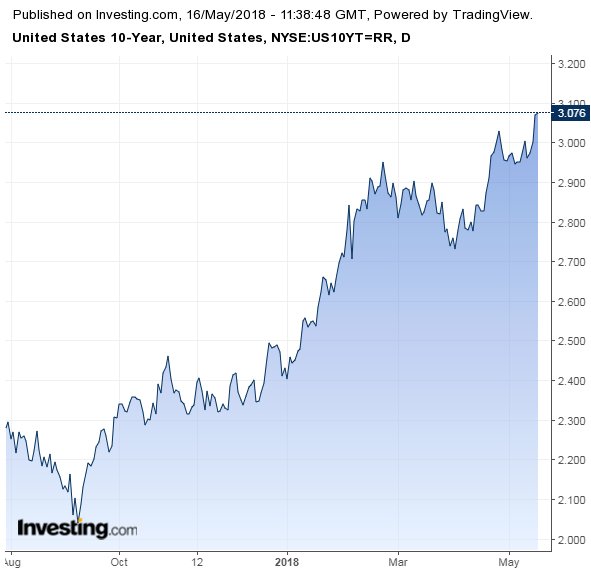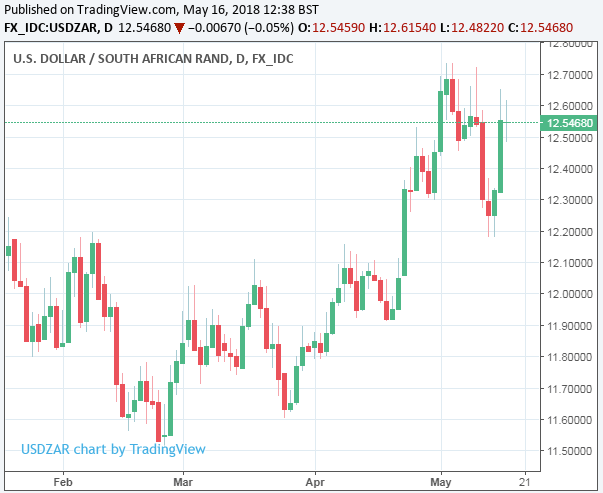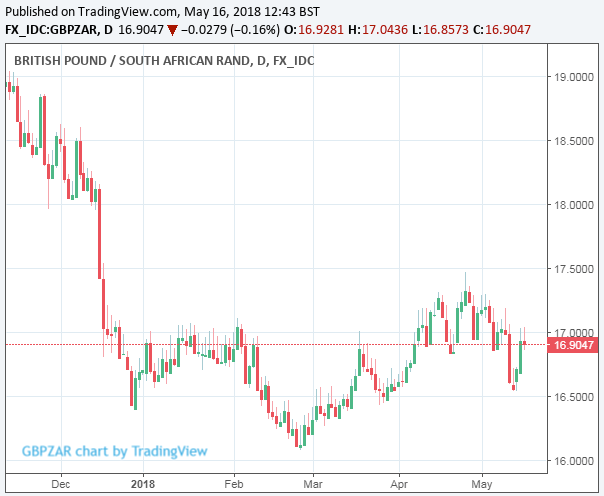Why It's Not all Downhill for the South African Rand
- Written by: James Skinner
- JPMorgan moderately bullish on the Rand
- USD/ZAR could fall 4% in next six weeks
- GBP/ZAR seen holding steady.

© Rawpixel.com, Adobe Stock
The South African Rand stabilised against a host of peers in mid-week trade largely thanks to the rampant US Dollar taking a breather from it ongoing advance.
South Africa's Rand has handed back all of its 2018 gains over the US Dollar and Pound Sterling in recent weeks as investors dumped emerging market assets by the bucket-load after the US Dollar recovered from the depths of the three-year lows registered back in the first quarter.
The reversal of fortunes for the Dollar is largely taken to be the result of a sharp rise in US bond yields which are rising in response to the robust US economic growth story and expectations for higher rates of inflation.
The rising yield paid on US government bonds is meanwhile proving attractive to international investors who are opting to buy into US bonds at the expense of South African bonds, which bids up the value of the Dollar at the expense of the Rand.
The stronger Dollar meanwhile raises the cost of servicing South Africa's own debt that is denominated in foreign currency, while pushing up the cost of imports such as fuel which could act as a drag on the South African economy, in short we are seeing a cocktail of conditions that are proving unfavourable to ZAR.

But, it's Not All Downhill for the Rand
Yet, some analysts are arguing the worst might now be over for the Rand, and are forecasting a modest recovery in the currency during the months ahead.
"ZAR has proven relatively more resilient in the recent market rout than most other high yielders. From current levels, we believe it is likely to attract renewed foreign inflows as EM FX recovers," says Anezka Christovova, an emerging market strategist at J.P. Morgan. "We are now modestly bullish on ZAR expecting a contained recovery after the recent sell-off."
The J.P. Morgan FX team say foreign money should favour emerging markets over the coming months and that South Africa is well placed to attract a decent share of any new inflows given superior "real yields" offered by South African government bonds and country-specific risks that have left Turkey and Russia looking less appealing to international investors.
"While inflation is likely to continue surprising to the downside, especially vs. the SARB our economist does not forecast further rate cuts this year," writes Christovova, in a recent note. "This cautious approach is positive for FX. We believe it will also prove positive for long-end rates as inflation targeting credibility improves."

Above: USD/ZAR rate shown at daily intervals.
Christovova suggests there will not be a second interest rate cut from the South African Reserve Bank this year because that would merely fuel inflation and the central bank has been seeking to reduce longer-term inflation expectations. This is undoubtedly a positive for the Rand because an interest rate cut would reduce the appeal of South African assets to international investors. Some of these views also chime broadly with those touted by strategists at Morgan Stanley.
"We see the recent Emerging Market FX sell-off as a temporary adjustment before a longer-term reversal. EM has experienced significant inflows over the past couple of years and we believe that real money investors entered 2Q with significant overweight exposure in EM currencies," says Hans Redeker, head of G10 FX strategy at Morgan Stanley, in a recent note. "This meant they were vulnerable to a rebound in USD and position-squaring became inevitable in order to prevent underperformance versus their benchmarks."
Given the extent of the emerging market sell-off seen over the last eight weeks, which has pushed the Rand alone 8% lower against the Dollar, Redeker says current levels have left some emerging market currencies looking attractive enough to think about buying. South Africa's Rand is the Morgan Stanley FX team's favourite emerging market currency.
"One investor, who has been trading South Africa for over 20 years, mentioned to us last year that there are two rules in the South African market: the first rule is never buy ZAR and the second rule is to follow the first rule. Post ANC conference, he said those two rules no longer apply and there is a green light to buy South Africa. We agree," says Redeker.

Above: Pound-to-Rand rate shown at daily intervals.
The changing of the guard in South African politics that saw Jacob Zuma resign as President earlier this year to be replaced by Cyril Ramaphosa has cast South Africa in a new light for international investors. However, much of this good news for more markets is already reflected in South African asset prices, but Morgan Stanley argue the Ramaphosa administration and its reform process is still young.
"While much of the good news is in the price, what likely is not in the price is the confirmation of a structural recovery in South Africa, driven by stronger consumption and higher investment," says Redeker. "Our argument to buy ZAR is not based on its cheap valuation, but on our belief that foreign inflows into local bond and equity markets and the President's plan to bring $100bn FDI should drive ZAR stronger."
Both Morgan Stanley and J.P. Morgan are forecasting a new recovery for the South African Rand during the months ahead.
J.P. Morgan project the USD/ZAR rate will fall from 12.53 Wednesday to 12.10 before the end of June, representing a gain of just more than 4%, before settling around the 12.30 area in time for year-end. They also project the Pound-to-Rand rate will rise from 16.91 Wednesday to 16.94 and remain close to that level until the first quarter of 2019.
Morgan Stanley have downgraded their Rand forecasts of late but still predict a steady push higher for the South African currency. They say the USD/ZAR rate will fall from 12.53 Wendesday to 11.60 before the end of September and 11.40 by year-end. They also project the Pound-to-Rand rate will fall from 16.91 Wednesday to 15.31 before the end of September before settling at 15.62 for year-end.
Advertisement
Get up to 5% more foreign exchange by using a specialist provider to get closer to the real market rate and avoid the gaping spreads charged by your bank when providing currency. Learn more here.




